A young lady from Chengdu, only 30 years old, was in debt of millions from online stock and cryptocurrency trading 10 years ago. Now she has achieved the goal of running a Faraday Future single-handedly, with a monthly income of 7 figures and an annual income of 8 figures. She is also a friend of mine in the cryptocurrency circle for many years. We met a while ago and talked about her glorious history. She spent 3 years learning and practicing in the cryptocurrency circle. She said that making money is too easy, and many people think too complicatedly. She mastered a set of indicators and made orders based on charts. She would not make orders without seeing any patterns. Her winning rate is as high as 100%, and she has won every battle.
Through my own practice, my winning rate is surprisingly as high as 100%. I have sorted it out in the past few days and now share it with those who are interested. Let’s learn and master it together. It is worth collecting!
Attached is a beautiful picture of the young lady
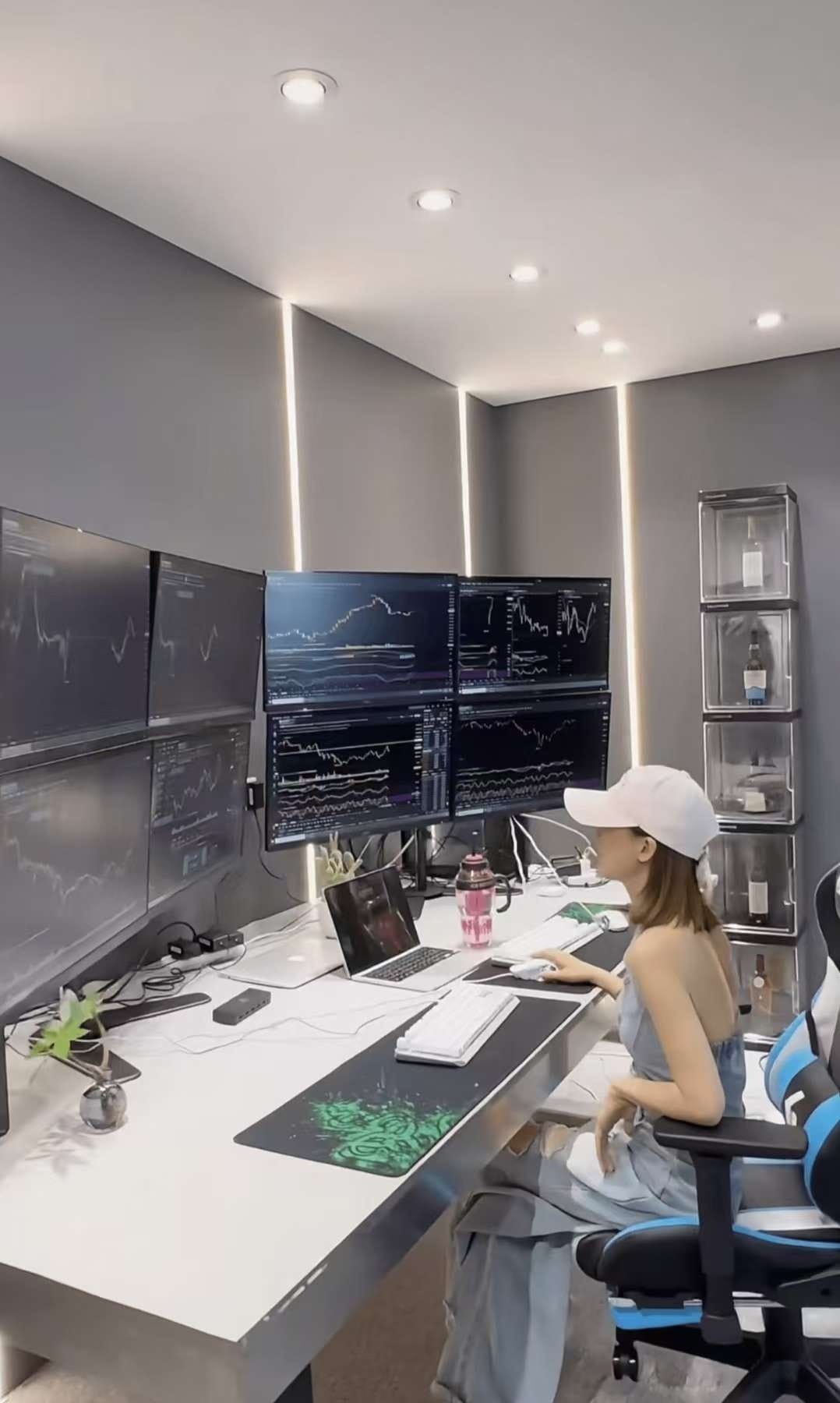
A must-read for cryptocurrency debt holders: From online loan defaults to stable profits, relying on small orders to make steady profits
In the past few years in the cryptocurrency world, I've witnessed too many heartbreaking tragedies: a college student using online loans to leverage 100x, only to have debt collection calls made to their counselor after their position went bust; a food delivery driver mortgaged his only house to cover his position, and ended up nearly selling his electric bike; a mother maxed out three credit cards to cover her bills, having to borrow even for her child's milk powder...
In reality, debt isn't the real threat; what's truly terrifying is trying to fill it with a gambler's mentality—the more desperate you are to recoup your losses, the deeper the hole you'll fall. Let me share with you my experience over the years in helping people pay off their debts. Contracts are inherently a high-risk battlefield. If you can't handle it, it's better to just live a normal life, where you can still find contentment in the daily grind.
Step 1: Cut off the “toxic source of funds” first and don’t let debt snowball
The root cause of debt is often not a loss of money, but a vicious cycle of "taking money from one pocket to pay for another." I met a man who initially lost 50,000 yuan and borrowed online loans to recover his losses. His losses only worsened, and he ended up with a debt of 300,000 yuan. The first step to clearing debt is to cut off the source of borrowing:
Immediately deactivate all lending tools: Freeze Huabei, credit cards, and online loan apps, and reduce your balance to the minimum. Don't believe that "using new debt to pay off old debt will alleviate the problem." High pressure will inevitably lead to distorted financial strategies—you'll overinvest in bets out of fear of defaults, and you'll continue to hold onto orders out of a rush to repay, ultimately spiraling out of control.
Last year, I mentored a single mother who initially used her credit card to cover her balances. I caught her there, and she was forced to close it. She said, "Although I felt a lot of pressure when I closed my online loan accounts, I felt a sense of peace of mind because I no longer had to calculate interest every day." Later, she slowly paid off her debts through steady operations, and she finally realized: if you don't borrow, you won't lose more money.
Step 2: Establish a "safe warehouse" to put on a life jacket for funds
No matter how much capital you have left, even if it is only 2000U, you must split the funds according to this ratio. This is the bottom line for survival:
20% U-margined contracts: Only open 1-3x leverage (never 5x or more), and limit your position size to no more than 30% of this capital. For example, if you have 2000U principal and 400U in contract funds, the maximum single position size is 120U. Even if your position is liquidated, you only lose 120U, leaving no damage to your foundation.
50% spot: Prioritize mainstream coins like BTC and ETH, and avoid altcoins. Even if spot prices fall, there's still a chance they'll recover, but if altcoins plummet, they might actually go to zero. During last year's bear market, a friend invested 50% in BTC. Although it dropped 30%, this year's rebound not only recouped his investment but also earned him 20%.
30% stablecoin investment: put it in a decentralized investment platform (for example, one with an annualized rate of return of 5%-8%). This part of the money is "emergency food" and should not be touched unless absolutely necessary. Even if you earn enough to buy a cup of milk tea every day, it is better than losing it all.
Remember: high leverage is poison when you're in debt. 100x leverage might seem like a quick win, but a 1% fluctuation can wipe out your position, and you simply can't withstand the normal fluctuations of the cryptocurrency market.
Step 3: In and out quickly, using "small steps and steady wins" to reduce debt
Debt repayment isn't about getting rich overnight, but about making a little money every day, accumulating little by little. The "hotspot quick attack strategy" I've developed is suitable for debt-ridden periods:
Only trade 1-3 times a day: Focus on small 5-15 minute market movements and avoid long-term holdings. The cryptocurrency market fluctuates rapidly, so small trades make it easier to capitalize on these swings and avoid the harmful effects of staying up late.
Choose the right coin: Choose mainstream coins with a daily volatility >5% (e.g., BTC, ETH, SOL). Too low a volatility will make you lose money, while too high a volatility will easily lead to pitfalls. Avoid altcoins that suddenly surge by more than 10%, as these are likely a scam.
Stick to stop-loss and take-profit strategies: Set a 1-2% stop-loss when opening a trade (for example, if you're long, immediately cut your losses if the price drops 2%), and a 2-5% take-profit (if the price rises 3%, sell half and keep the other half to see the trend). Don't be greedy and hope for a "bigger rise," and don't be lucky and hope for a "rebound." Mechanical execution is more important than anything else.
Stop trading when your daily profit exceeds 5%. For example, if you have a 2,000U investment and earn 100U per day, shut down your computer. Don't try to "take advantage of my luck and make more." Last year, a mother used this rule to earn 30-50U per day and paid off her 380,000 yuan debt in 6 months.
Fatal Taboos: If You Do These 4 Things, Your Debt Recovery Will Fail
During the debt period, any mistake may make you start all over again. These 4 red lines must not be crossed:
❌ Do not hold onto orders for more than 4 hours: If you lose money on an order, accept it. Holding onto an order for more than 4 hours will cause your mind to break down, often leading to a margin call. I once saw a delivery guy hold onto an order for 3 days, going from a 5% loss to a 50% loss. He almost lost his house.
❌ Trading is prohibited between 22:00 and 2:00: This time period is when the cryptocurrency market fluctuates the most and is most susceptible to manipulation. Furthermore, staying up late to trade will cause your mind to be unclear, and your error rate will double.
❌ Do not operate more than two coins simultaneously: Multi-coin operation will distract you, and you will end up not doing well in any of them. Focusing on one mainstream coin is 10 times more reliable than randomly trading three altcoins.
❌ Avoid opening positions when you're emotionally charged: Avoid opening positions after an argument, staying up late, or losing money. 90% of your decisions during these times are likely to be wrong. You can set a "cooling-off period": when you're feeling down, force yourself to refrain from trading for an hour.
Finally, I want to say: The most fair thing in the cryptocurrency world is "everyone is equal before discipline"
I have seen a single mother pay off 380,000 US dollars in 6 months with 2,000 US dollars. It was not luck that made the difference, but the small profits she made every day. I have also seen rich second-generations use 1 million US dollars as capital and 100 times leverage to chase altcoins, and finally lost 911 to the amount of Meituan and eMule. What they lost was not money, but discipline.
The key to clearing debt isn't about getting rich quick, but rather using mechanical trading to smooth out the debt curve. Earn a little every day, avoid greed and gambling, and your debt will slowly decrease like an hourglass. If you're currently in debt, don't panic. Cut your debt first, build a safe position, and earn money slowly with small trades.
The cryptocurrency world isn't just about being a "gambler." Maintaining discipline, even if you earn just 100 units a day, will help you escape the abyss. Remember: only those who can manage risk are qualified to profit.
Making money in the cryptocurrency world doesn't rely on metaphysics, but on using simple techniques thoroughly and using rules as a foundation. Only in this way can you avoid pitfalls and make more money in the short term. Follow me for more simple and practical operation skills, and let technology become your confidence in making money~
To make $1 million in the cryptocurrency world, you either have to rely on a bull market and hold on, or you have to bet on a lucky coin, or you have to use high leverage to bet on the right direction. But most people lose money, so don’t just rely on the get-rich-quick stories; first determine how much risk you can tolerate.
If you are also a fan of cryptocurrency technology, click on the coin homepage.
Click on the avatar to follow me and get first-hand information and in-depth analysis!
A personally tested method, using only 500,000 yuan to achieve a record of 10 million, using only this one trick (Wolf Wave Trading Strategy), the winning rate is as high as 99%, suitable for everyone!
Looking back at when I first entered the trading market, I tried every possible way to find knowledge about this on the Internet, hoping to learn everything as soon as possible so that I could start practicing and make money as soon as possible.
Here’s some useful information for you!
No indicators are needed to profit from large swings! The most comprehensive Wolfe Wave Trading Strategy tutorial on the web: drawing, rules, entry and exit, stop-loss and take-profit, all included

I've mentioned the Wolfe Wave pattern several times in previous articles. It's a powerful chart pattern that often appears near the end of a price trend. Therefore, it's considered a counter-trend trading strategy. The Wolfe Wave pattern has proven to be a reliable trading signal that technical analysts should study and understand. This article will focus on the most important characteristics of the Wolfe Wave pattern and some best practices for applying it in the markets.
Understanding Wolfe Waves
Wolfe Waves are a unique pattern that appear in price series. A typical Wolfe Wave structure consists of five bands that exhibit a very symmetrical shape in either a bullish or bearish context. This pattern most often appears within an ascending or descending trend channel.
While this pattern can also occur in range-bound markets, the most ideal Wolfe Wave patterns typically exhibit some degree of trend in price action. Technical traders can use this pattern to more effectively time their trades. To correctly identify this structure, certain very specific Wolfe Wave rules must be met.
The Wolfe Wave concept was developed and introduced to the technical analysis trading community by Bill Wolfe. Wolfe Wave patterns can occur in freely traded and liquid financial markets across all timeframes.
Therefore, Wolfe Wave patterns are considered to have fractal characteristics and can appear on very small timescales, such as one-minute or five-minute charts, as well as on larger timescales, such as weekly or monthly charts.
When traders can correctly identify a Wolfe Wave pattern, they can execute a buy or sell setup at a high-probability reversal point and precisely determine the target price for the trade. Therefore, Wolfe Wave patterns can be an excellent addition to any technical analysis trader's arsenal. Next, we'll take a closer look at what a Wolfe Wave pattern looks like.
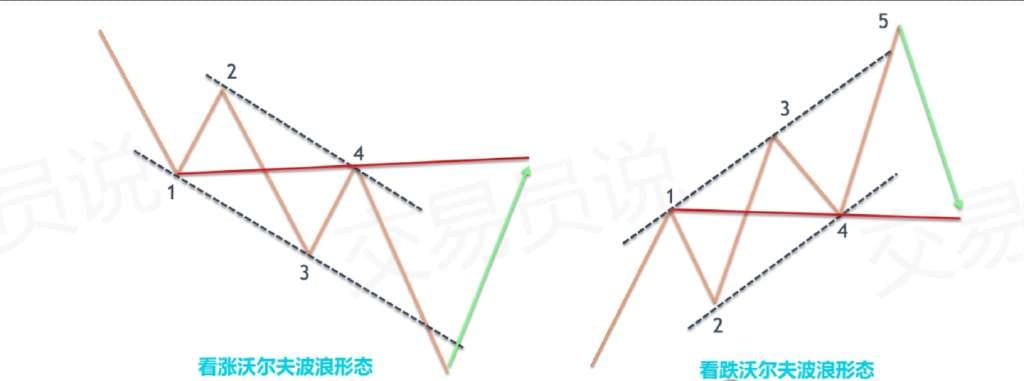
In the image above, the left side shows a bullish (bullish) Wolfe Wave pattern, while the right side shows a bearish (bearish) Wolfe Wave pattern.
The bullish Wolfe Wave pattern generates a buy signal near the end of wave 5, when the 1-3 trendline has been broken downwards. After that, the price is expected to rise and encounter resistance near the 1-4 trendline.
The bearish Wolfe Wave pattern generates a sell signal near the end of wave 5, when the 1-3 trendline has been broken upwards. Subsequently, the price is expected to decline and find support near the 1-4 trendline.
Bullish Wolfe Wave Pattern
Wolfe Waves typically form within parallel or equidistant channels. In other words, they appear between two relatively parallel trendlines. A bearish Wolfe Wave pattern consists of five price swings of roughly equal length and exhibit symmetry.
In the image below, you can see an example of a bullish Wolfe Wave pattern.
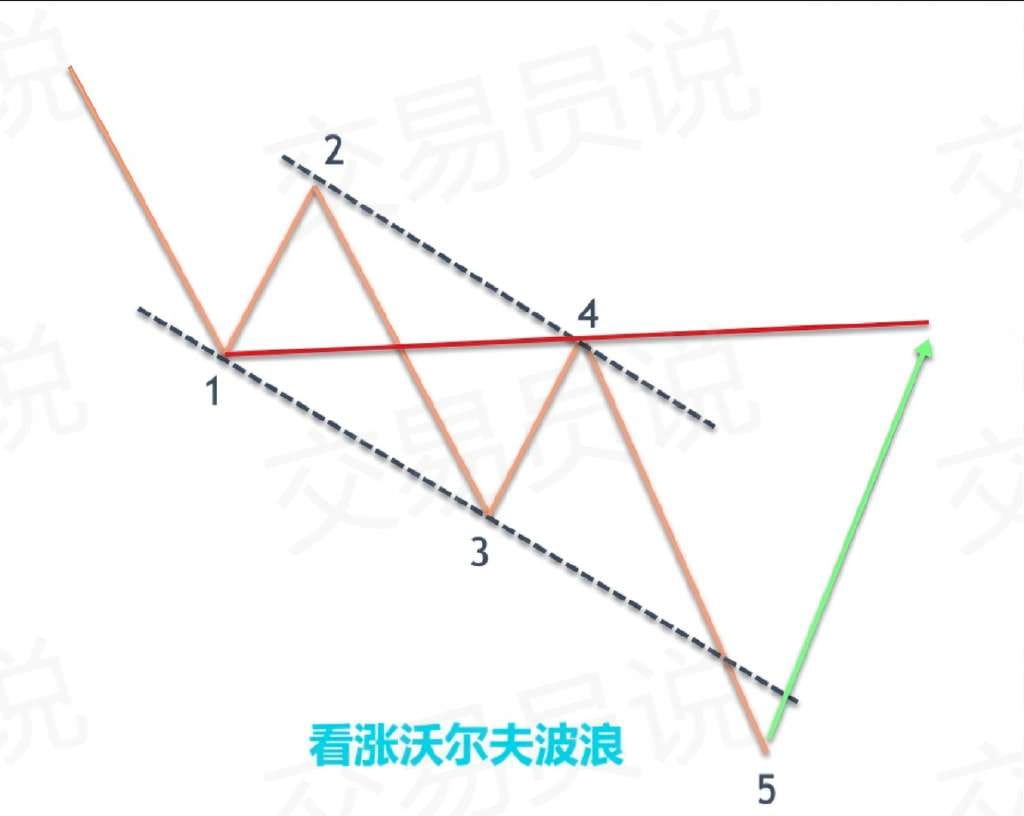
The bullish Wolfe Wave pattern begins with a decline in wave 1. At some point, wave 1 forms a swing low, after which the price begins a rebound upward in wave 2. After wave 2 ends, wave 3 begins another decline, ultimately falling below the starting point of wave 1. This is followed by wave 4, which rises, but its high is lower than the high of wave 2.
At this point, we need to draw a trend line connecting the end points of waves 1 and 3, called the 1-3 trend line. At the same time, we also need to draw a trend line connecting the end points of waves 2 and 4, called the 2-4 trend line. We want to see the 1-3 trend line roughly parallel to the 2-4 trend line.
Finally, the fifth wave should extend downward, breaking through the swing low of the third wave and breaking below the lower boundary of the 1-3 trendline.
A buy signal is triggered when the price breaks below the 1-3 trendline, finds support in that area, and re-enters the channel. Once the price re-enters the channel, we can confidently label the structure as a valid bullish Wolfe Wave pattern.
The Bullish Wolfe Wave pattern is a counter-trend trading strategy. We seek to enter a long position against the overall downtrend in order to capture an impending upside reversal. The Bullish Wolfe Wave structure provides a target level, calculated from the 1-4 trendline. When the price approaches this level, it is expected to encounter resistance, making it a good opportunity to exit our long position.
Bearish Wolfe Wave Pattern
Similar to the bullish Wolfe Wave variant, the bearish Wolfe Wave pattern occurs within a parallel channel, with the rising trendline 1-3 forming a relatively close angle with the rising trendline 2-4. This bearish Wolfe Wave pattern also consists of five price bands that are relatively close in length and display a degree of symmetry.
Now let’s dive into the details of the Bearish Wolfe Wave structure. The image below again shows a Bearish Wolfe Wave pattern.
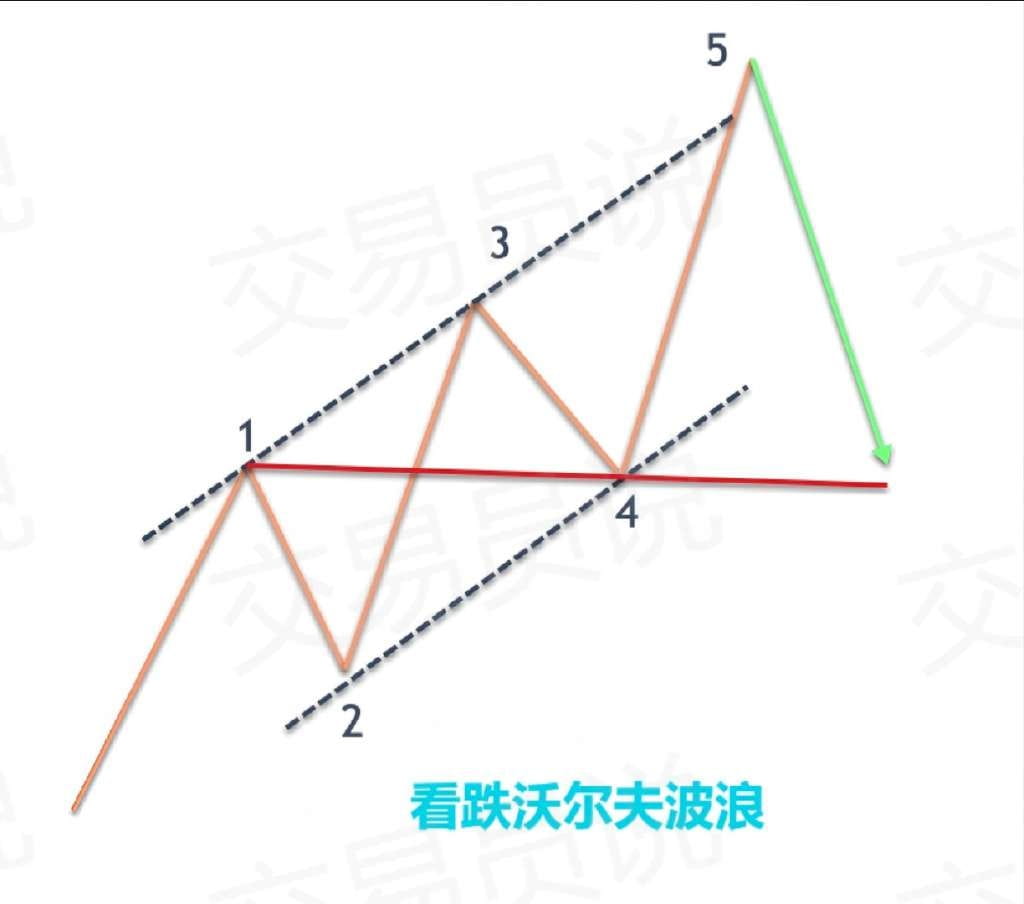
The bearish Wolfe Wave pattern begins with an upward move in the first wave. Subsequently, the second wave appears and declines, forming a swing low above the starting point of the first wave. The third wave then begins to rise, ending above the end of the first wave. The fourth wave then moves in the opposite direction of the third wave, retracing downward and ending above the swing low of the second wave.
At this stage, you need to draw a trendline connecting the end points of waves 1 and 3. Also draw another trendline connecting the end points of waves 2 and 4. These two trendlines should appear roughly parallel. The final wave, wave 5, should slightly break above the upper trendline (specifically trendline 1-3). This is often considered a false breakout.
The true sell entry signal occurs when the price breaks out of the upper trendline and then retraces back into the channel. The price is rejected from this upper area and returns back into the channel, confirming the validity of the Wolfe Wave pattern.
As you may have noticed, the Bearish Wolfe Wave pattern is a counter-trend trading strategy that aims to short-term "top-fish" an uptrend at a high-probability turning point. Upon entering a Bearish Wolfe Wave pattern, a target price can also be calculated.
To calculate this expected price action, we need to draw a trend line connecting the end points of wave 1 and wave 4 and project it forward. When price action approaches this 1-4 trend line, we can expect the price to find support there again.
Wolfe Wave Trading Strategy
Now let's build a complete trading strategy based on the Wolfe Wave pattern. This will be a purely price action-based strategy, meaning we will not use any other technical indicators or oscillators, but instead focus on the price structure that forms the Wolfe Wave pattern.
Call trade entry rules
⊙ We need to confirm that the price is in a downtrend.
Once a potential bullish Wolfe Wave pattern has been identified, it is necessary to mark each wave within the pattern.
Draw a line connecting waves 1 and 3, and another line connecting waves 2 and 4. These two lines should form a relatively parallel price channel.
⊙ Wave 5 should break through the 1-3 trend line, but quickly reverse and return to this parallel channel.
A buy entry signal is triggered when the price closes bullishly inside the channel.
⊙ Stop loss should be set below the low point of wave 5.
Draw a trend line connecting Wave 1 and Wave 4 and extend it forward. This will serve as the target level. When the future price touches this target line, close the position.
Put trade entry rules
⊙ We need to confirm that the price is in an uptrend.
Once a potential bearish Wolfe Wave pattern has been identified, it is necessary to mark each wave within the pattern.
Draw a line connecting waves 1 and 3, and another line connecting waves 2 and 4. These two lines should form a relatively parallel price channel.
⊙ Wave 5 should break through the 1-3 trend line, but quickly reverse and return to this parallel channel.
A sell entry signal is triggered when the price closes bearishly within the channel.
⊙ Stop loss should be set above the high point of wave 5.
⊙ A trend line connecting waves 1 and 4 and extending forward will serve as the target level. When the future price touches this target line, close the position.
Bullish Wolfe Wave Strategy Example
Next, let's look at a price chart to illustrate the Wolfe Wave trading system outlined in the previous section. In the price chart below, you'll see a Wolfe Wave pattern that has been seen in the markets all year. Specifically, this example shows a bullish Wolfe Wave setup on the 240-minute timeframe for the USD/CAD currency pair.
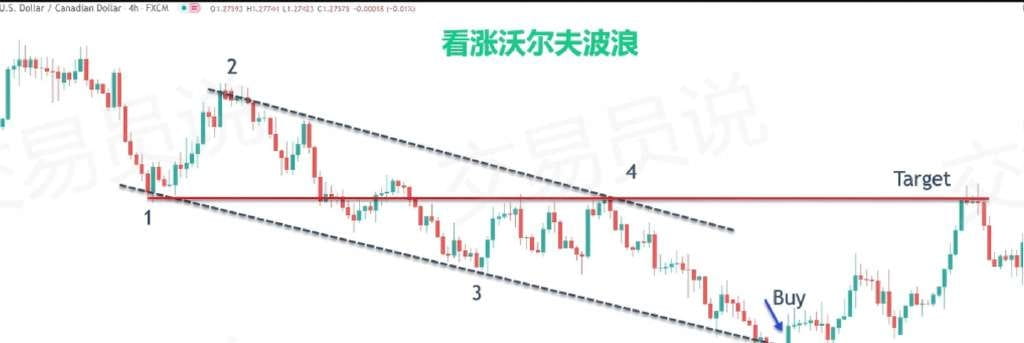
Let's now break down this potential bullish Wolfe Wave pattern and see how to trade it according to the rules we laid out earlier. First and foremost, we must ensure that USDCAD is in a downtrend. This is readily apparent from the price chart. As the downtrend progresses, we will at some point identify a potential bullish Wolfe Wave pattern forming.
We will number each wave in the structure, starting with wave 1. When the movement enters the early stages of wave 5, we can draw two trend lines.
The first is the 1-3 trend line, which connects the swing lows of waves one and three.
Additionally, we will draw a second trend line connecting the swing highs of waves 2 and 4. Once this is done, we will check back on these two trend lines to confirm that they are roughly parallel.
At the end of wave 5, we can see that the price fell below the 1-3 trend line, but was quickly blocked and rebounded back into the price channel. Note the first green candlestick that closed within the channel in the chart - this is our entry signal to go long on the USDCAD currency pair.
After the buy order is executed and the long position is established, we will immediately place a stop-loss order to protect against any adverse price movements. The stop-loss level will be placed below the swing low of wave 5, as shown by the orange line labeled "Stop" in the chart.
Next, we need to mark a potential exit point for this trade. Remember, to do this, we'll draw a trendline connecting the end points of waves 1 and 4 and project it forward. This is illustrated on the price chart with the dark red line.
Notice how the price entered this target area and broke slightly upwards before encountering resistance and pulling back. Luckily, we would have closed the position at an ideal moment, pocketing a nice profit.
Bearish Wolfe Wave Strategy Example
Now let's look at a second example of a Wolfe Wave strategy. This time, we'll focus on a bearish Wolfe Wave structure. Below is a price chart of the USD/JPY currency pair on the 240-minute timeframe.
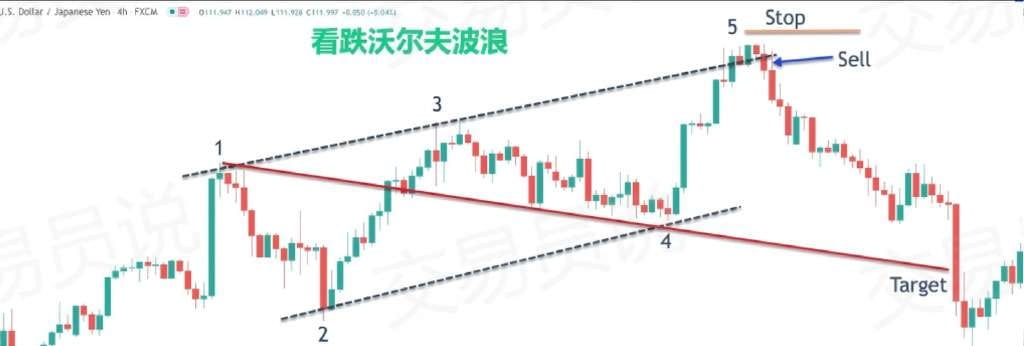
Starting from the far left side of the price chart, we can see that the price action is rising, thus satisfying the initial conditions of the bearish Wolfe Wave strategy. As the price continues to rise, we can see a "stair-step" price movement, which constitutes waves 1 through 5.
More specifically, we can see that waves 1 and 3 rose in the direction of the overall trend, while waves 2 and 4 acted as counter-trend pullbacks, retracing portions of waves 1 and 3. As the price continues to rise in the early stages of wave 5, we can identify a potential bearish Wolfe pattern developing.
Next, we draw a trend line connecting the swing lows of waves 2 and 4 to form the lower boundary of the parallel channel, and another trend line connecting the swing highs of waves 1 and 3 to form the upper boundary of the parallel channel.
At this point, we waited to see if the price action in wave 5 would break through the 1-3 trendline, thus providing a potential shorting opportunity. As shown in the chart, wave 5 did indeed break through the 1-3 trendline and began consolidating in that area. However, the price was quickly rejected to the downside, thus confirming the formation of a bearish Wolfe Wave pattern.
Next, we'll use a market order to short the USDJPY currency pair when price first breaks back down into the parallel price channel. This point is indicated on the chart by the blue arrow labeled "Sell." Once our sell order is triggered in the market, we'll focus on setting a stop-loss.
According to our rules, a stop-loss order should be placed above the swing high of wave 5. The trade's exit target is estimated using the 1-4 trendline. We connect the swing high of wave 1 with the swing low of wave 4 and project this trendline forward. Notice how the price enters this target area before reversing upwards.
Summarize
The Wolfe Wave pattern is a lesser-known chart pattern, but it can be a very powerful one when used correctly. Wolfe Wave patterns appear in many different markets, including stocks, futures, and forex. They can also be observed on a variety of different timeframes.
That being said, the most ideal and reliable Wolfe Wave pattern trading opportunities typically occur on the four-hour chart and above. Technical analysts should focus on these cycles when searching for high-probability Wolfe Wave patterns. Traders can either manually identify these patterns on the price chart or use the Wolfe Wave indicator to assist in their identification.
It's worth noting that this pattern is often confused with the Elliott Wave Impulse structure. While there are some similarities between the Wolfe Wave pattern and the Elliott Wave Impulse structure, there are also very distinct differences. While a detailed comparison and analysis of these differences is beyond the scope of this article, it's a topic for serious chartists to delve into.

6 Trading Rules for Survival in the Cryptocurrency Circle: What I Learned After 5 Liquidations!
Brothers, stop asking "how to make money in the cryptocurrency world" and first understand "how to survive." It took me five margin calls to finally understand: the cryptocurrency world isn't about who makes money fast, but who survives the longest. Master these six survival systems, and even those with average skills can survive the market.
1. Capital Management: The 1% Risk Rule Locks the Bottom Line
The single risk must never exceed 1% of the principal. This is the iron rule for saving life.
Algorithm: With a capital of 100,000 yuan, the maximum loss in a single transaction is 1,000 yuan. The position can be calculated in reverse order (for example, with a 3% stop-loss for a BTC contract and 10x leverage, a position of only 3,333 yuan can be opened at a time).
Split your portfolio into 5 units: 3 for trend trading and 2 for swing trading. Stop trading if you lose all of 1 unit in a trend trade, and stop trading if you suffer two consecutive losses in a swing trade. Last year, a student used this strategy to consistently earn 20,000 yuan a year with a 50,000 yuan investment, with a maximum drawdown of only 8%.
2. Double Stop-Loss Insurance: Double Blockage of Technology and Funds
Technical stop loss: For trend orders, look at the 4-hour MA20, and cut if it falls below it; for swing orders, use 2×ATR (for example, ATR500, stop loss 1000).
Capital stop loss: Cut losses immediately when the loss reaches 1% of the total capital, regardless of technical factors.
A tough trick: Use conditional orders to set stop-loss in advance, set the stop-loss when placing the order, and let the system take control.
3. Position Dynamic Balance: Keep 30% in Cash for Both Bull and Bear Markets
Bull market position = (current price ÷ previous historical high) × 100% (e.g. BTC 50,000 ÷ previous high 69,000 ≈ 72% position).
Bear market position = (previous historical low ÷ current price) × 30% (e.g. BTC 30,000 ÷ previous low 15,000 × 30% = 15% position).
Adjustment signal: If the weekly MACD golden cross rises by 10%, add 10% to the position; if the weekly MACD dead cross falls by 10%, reduce 10% of the position. Use mechanical operations to avoid emotions.
4. Market Filtering: 90% of Markets Should Be Abandoned
Three-cycle resonance before taking action:
Only go long when the weekly MA5 is above MA20, and go short when the weekly MA5 is above MA20, and keep a short position when the market goes sideways.
The trading volume must be magnified by more than 1.5 times, otherwise it is a false market.
Only enter the market at the beginning/middle of the month in a bull market and at the end of the quarter in a bear market, and avoid the 3 days before and after the delivery date.
5. Emotional Management: Mechanical Execution Schedule Instead of Brain
Pipeline transactions and standardize decisions using execution tables:
If the profit reaches 30%, the position will be forced to close at 20%, and if the loss reaches 1%, it will be cut immediately.
A single violation will result in a 24-hour trading suspension, and we rely on rules to combat human weaknesses.
6. Counterintuitive Techniques for Surviving a Bear Market
Position swap: 80% of altcoins are swapped for BTC, with the least drop and the fastest rebound.
Option insurance: For every 20% drop, spend 1% of the principal to buy call options. When the price reaches $16,000 in 2023, you will earn $30,000 on a $5,000 option.
Frequency reduction: Transaction once per month, saving 80% in transaction fees.
Conclusion: The ultimate secret to survival is accepting mediocrity. I rely on the simple method—strict fund management, mechanical execution, and 90% of the time short positions—to achieve steady annual growth. The rule of the cryptocurrency world isn't offense, but defense. If you can survive a bull market and earn 20% compound annually, you're a winner.
Survival Dashboard: Three daily questions - Drawdown exceeding 5%? More than 3 trades per week? Violation of the execution table? Only meet all the requirements to pass.
How many people, driven to despair by market volatility, have relied on this system to stabilize their positions, or even turn things around? Countless—but the key lies in this: dare to follow, dare to act, and do not drag your feet.
To make $1 million in the cryptocurrency world, you either have to rely on a bull market and hold on, or you have to bet on a lucky coin, or you have to use high leverage to bet on the right direction. But most people lose money, so don’t just rely on the get-rich-quick stories; first determine how much risk you can tolerate.
If you are also a fan of cryptocurrency technology, click on the coin homepage.
Click on the avatar to follow me and get first-hand information and in-depth analysis!